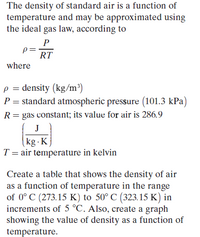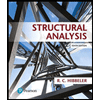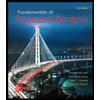
Structural Analysis
6th Edition
ISBN: 9781337630931
Author: KASSIMALI, Aslam.
Publisher: Cengage,
expand_more
expand_more
format_list_bulleted
Concept explainers
Question

Transcribed Image Text:The density of standard air is a function of
temperature and may be approximated using
the ideal gas law, according to
P
p=
RT
where
p = density (kg/m³)
P = standard atmospheric pressure (101.3 kPa)
R= gas constant; its value for air is 286.9
J
kg Kj
T = air temperature in kelvin
Create a table that shows the density of air
as a function of temperature in the range
of 0° C (273.15 к) to 50° C (323.15 К) in
increments of 5 °C. Also, create a graph
showing the value of density as a function of
temperature.
Expert Solution
This question has been solved!
Explore an expertly crafted, step-by-step solution for a thorough understanding of key concepts.
This is a popular solution
Trending nowThis is a popular solution!
Step by stepSolved in 2 steps with 1 images

Knowledge Booster
Learn more about
Need a deep-dive on the concept behind this application? Look no further. Learn more about this topic, civil-engineering and related others by exploring similar questions and additional content below.Similar questions
- In an experiment to determine the viscosity of some oil, a ball is dropped into the oil. The position of the ball is given by the formula y(t) = A + Bt +C e−Dt, where y is given in m, and t is the time in s. At t = 0, y(0) = 0.05 m, the y component of the velocity is zero and the y component of the acceleration is ay(0)= 0.02 m/s2. As t approaches infinity, the y component of the velocity approaches vy(∞) = 0.55 m/s. Hint: You will likely want to answer the questions in a different order than presented. I am trying to figure this qeustion out, I need to find out what each of the variables in the fromula are. So far I have only found out what B is because I just toook the limit of the velocity function as t approaches zero, which gave me 0.55m/s. I am just stuck on how I would go about solving for the other variables in the question.arrow_forwardSolve both parts.arrow_forwardThe water in a tank is pressurized by air, and the pressure is measured by a multifluid manometer as shown in the figure. Determine the gage pressure of air in the tank if h1= 0.7 m, h2= 0.6 m, and h3= 0.8 m. Take the densities of water, oil, and mercury to be 1000 kg/m3, 850 kg/m3, and 13,600 kg/m³, respectively. Oil Air Water h Mercury The gage pressure of air in the tank is 49.8 kPa.arrow_forward
Recommended textbooks for you

 Structural Analysis (10th Edition)Civil EngineeringISBN:9780134610672Author:Russell C. HibbelerPublisher:PEARSON
Structural Analysis (10th Edition)Civil EngineeringISBN:9780134610672Author:Russell C. HibbelerPublisher:PEARSON Principles of Foundation Engineering (MindTap Cou...Civil EngineeringISBN:9781337705028Author:Braja M. Das, Nagaratnam SivakuganPublisher:Cengage Learning
Principles of Foundation Engineering (MindTap Cou...Civil EngineeringISBN:9781337705028Author:Braja M. Das, Nagaratnam SivakuganPublisher:Cengage Learning Fundamentals of Structural AnalysisCivil EngineeringISBN:9780073398006Author:Kenneth M. Leet Emeritus, Chia-Ming Uang, Joel LanningPublisher:McGraw-Hill Education
Fundamentals of Structural AnalysisCivil EngineeringISBN:9780073398006Author:Kenneth M. Leet Emeritus, Chia-Ming Uang, Joel LanningPublisher:McGraw-Hill Education
 Traffic and Highway EngineeringCivil EngineeringISBN:9781305156241Author:Garber, Nicholas J.Publisher:Cengage Learning
Traffic and Highway EngineeringCivil EngineeringISBN:9781305156241Author:Garber, Nicholas J.Publisher:Cengage Learning


Structural Analysis (10th Edition)
Civil Engineering
ISBN:9780134610672
Author:Russell C. Hibbeler
Publisher:PEARSON

Principles of Foundation Engineering (MindTap Cou...
Civil Engineering
ISBN:9781337705028
Author:Braja M. Das, Nagaratnam Sivakugan
Publisher:Cengage Learning

Fundamentals of Structural Analysis
Civil Engineering
ISBN:9780073398006
Author:Kenneth M. Leet Emeritus, Chia-Ming Uang, Joel Lanning
Publisher:McGraw-Hill Education


Traffic and Highway Engineering
Civil Engineering
ISBN:9781305156241
Author:Garber, Nicholas J.
Publisher:Cengage Learning